9 Types Of Hawks With WHITE BELLIES (ID Guide With Photos)
Did you recently come across a hawk with a white belly, and want to know what species it was?
Identifying hawks with a white underside is not as easy as it might seem, since there are many raptors in North America that fit this description.
To help you identify the bird you saw, we’ll cover the most common hawks with white bellies in North America in this article.

What types of hawks have white bellies?
There are 9 types of hawks in North America that have a white belly, and these are described in full detail below.
Let’s dive into the details, and take a closer look at each of these white-bellied raptors:
Swainson’s Hawk
Scientific name: Buteo swainsoni
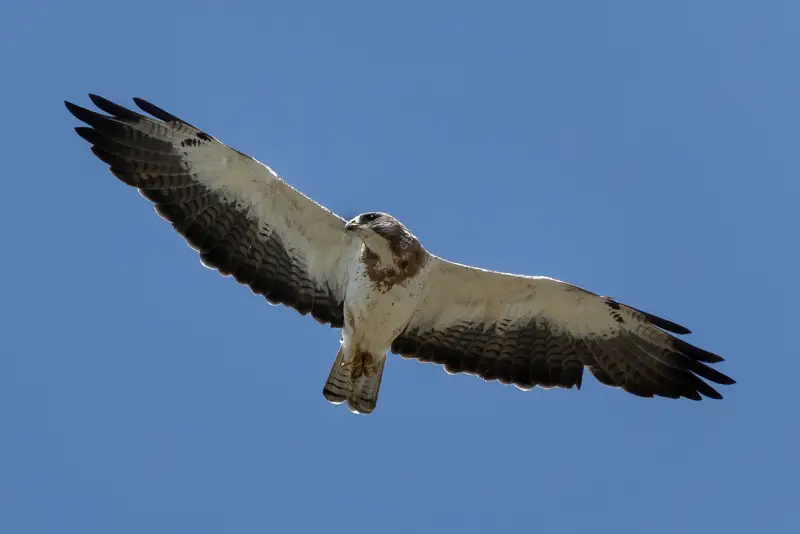
The Swainson’s Hawk is a compact buteo species that frequents dry prairies and open areas in western North America.
These raptors have long, narrow wings, and are best identified by their brown chest, which contrasts with their white belly, underwings and chin.
Another distinguishing feature of these hawks are their striped tail feathers.
In fall they gather in flocks numbering in the tens of thousands that migrate south together, often together with other raptor species, such as Broad-winged Hawks.
Swainson’s Hawks are summer visitors throughout the western half of North America, where they can be seen from April through September.
They are strictly migratory birds that spend the winter in Argentina.
Ferruginous Hawk
Scientific name: Buteo regalis
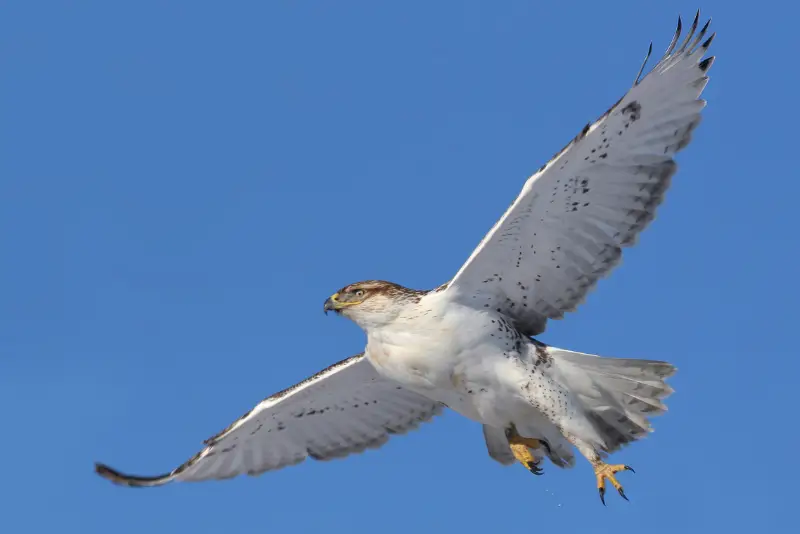
The Ferruginous Hawk is a very large buteo of the western prairies and deserts. With a wingspan of up to 56 inches, it is the largest hawk in North America.
This hawk is a breeding bird in northern parts of the western United States, and is a winter bird in southwestern states outside of the breeding season, as well as in Central America.
While it occurs in two color morphs (light and dark), the more common of these is the light morph.
The light morph is easily identifiable by its bright white underside, gray head, and rusty brown upperparts.
These birds of prey feed on rodents and other small mammals, with prairie dogs forming a large part of their diet.
White-tailed Hawk
Scientific name: Geranoaetus albicaudatus

These raptors are easily recognizable by their distinct markings, which include a white underside, bright white tail with a dark band at its ends, dark wings, as well as rufous brown shoulder patches.
These raptors are only found in southern Texas, where they occur in the coastal prairies close to the Mexican border.
They predominantly feed on lizards and small snakes, as well as insects and rodents.
Similar to kestrels, they like to hunt by “kiting,” which involves using the wind to hover in a fixed position, as they wait for prey to appear on the ground below.
Red-tailed Hawk (light morph)
Scientific name: Buteo jamaicensis
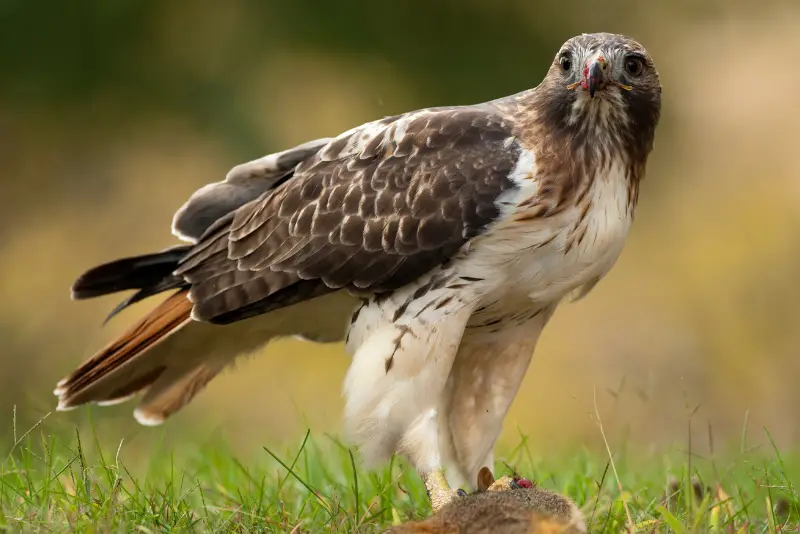
With a wingspan of up to 52 in (4.5 ft), the Red-tailed Hawk is one of the larger species of hawks in North America.
This common raptor has 3 different color morphs (light, dark, and intermediate), and while some individuals are almost entirely reddish brown, the light morph is largely white, and also has a white belly.
However, almost all Red-tailed Hawks can be recognized by their rusty red tail.
This large hawk is common in open grassland and also in cities. It is most often seen perched on roadside posts or fences, waiting for prey.
It feeds on rodents and other small animals that it catches by swooping down from its perch when they venture out into the open.
The Red-tailed Hawk is one of the most common hawk species in North America, and is a year-round resident throughout its range.
Short-tailed Hawk (light morph)
Scientific name: Buteo brachyurus

The Short-tailed Hawk is primarily a species of Central and South America, but also has a small breeding population in North America located in Florida.
These raptors occur in two color morphs: a light and a dark morph. The light morph of the Short-tailed Hawk has a bright white belly and chest, as well as white wing undersides.
While Short-tailed Hawks in central Florida are migratory, they are year-round residents in south Florida.
Great places to see these medium-sized raptors are the Florida Keys (especially Key West), and the Everglades National Park.
Unlike most other buteo species, Short-tailed Hawks specialize in hunting small birds, which they attack with high speed dives from high altitudes.
Northern Harrier (adult male)
Scientific name: Circus hudsonius

The Northern Harrier is a breeding bird of the northern parts of North America, but spends the winter in the southern USA and Central America.
Adult male Northern Harriers have a light grayish-blue upperside, as well as a white underside that contrasts with their black wing tips.
This harrier is a winter bird in many parts of the United States from October through April, where it frequents open grassland and marshes.
Harriers are most easily identified by their behavior. Their foraging tactic is to fly slowly just a few feet above the ground, in order to pounce on any rodent caught outside its burrow.
Swallow-tailed Kite
Scientific name: Elanoides forficatus

This elegant raptor is easy to identify in flight, due to the combination of its bright white belly, and white underside of its wings, as well as its deeply forked tail.
The rear margins of the wings and the tail are black. When perched on a tree, its white head and chest contrast with the dark grayish black upperside.
Similar to other kites, this elegant raptor is a skilled hunter and capable of catching insects in flight. Its preferred food are small reptiles, rodents, and insects.
The Swallow-tailed Kite is a summer visitor in southeastern North America, and migrates to Central and South America to spend the winter.
The largest population of breeding Swallow-tailed Kites is currently found in Florida, but it also breeds in other southern states.
White-tailed Kite
Scientific name: Elanus leucurus
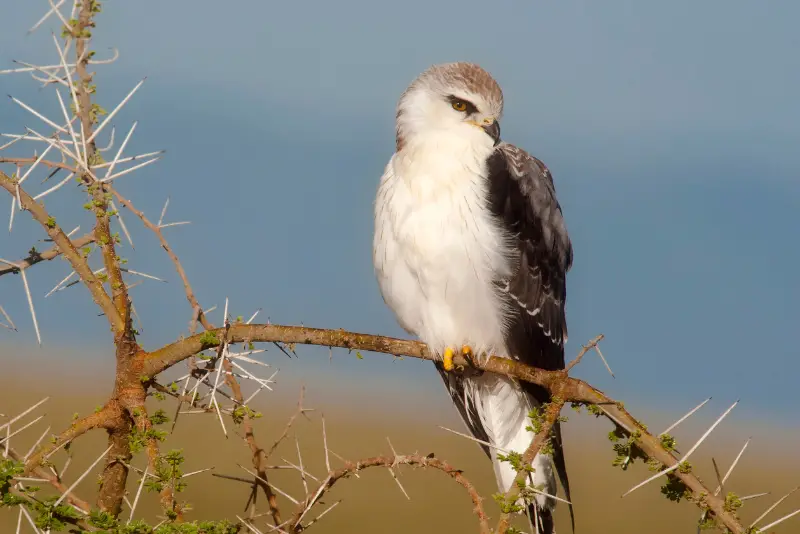
The White-tailed Kite is also known as the Black-shouldered Kite, and both of these are apt names for it.
Adult White-tailed Kites have an entirely white underside, head, and tail. Their upper side is light gray, with dark gray patches on the shoulders. The eyes are deep red.
Juvenile birds, on the other hand, have a more brownish color with light streaks.
White-tailed Kites hunt for small rodents, insects and reptiles in open grassland, either from a perch or on the wing.
Similar to kestrels, these birds like to hover in the air over a specific spot, while waiting for a rodent to come out of its burrow.
White-tailed Kites are scarce breeding residents along the western coast of North America, as well as several small populations in Texas and Florida. where these birds can be seen year-round.
Mississippi Kite
Scientific name: Ictinia mississippiensis
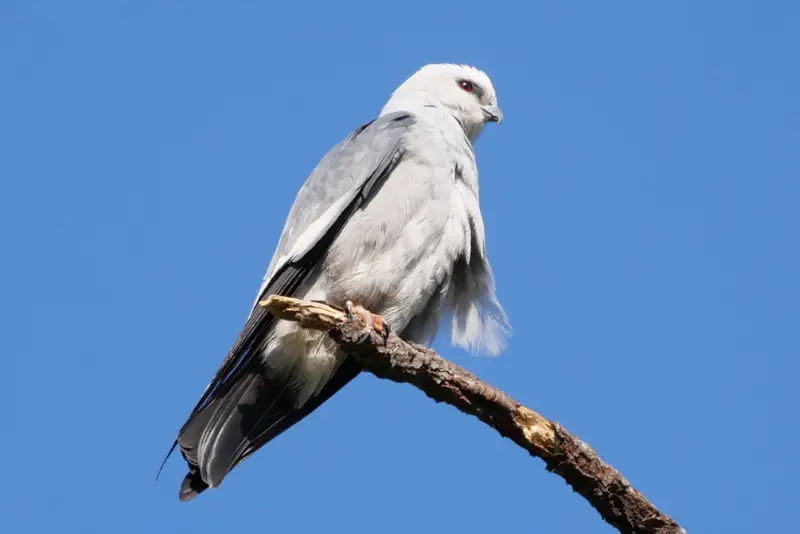
The Mississippi Kite is a sleek raptor with pointed wings resembling those of a falcon. It is a skilled aerial hunter that often hovers and then swoops down to catch flying insects on the wing.
It is a breeding bird in the southwestern United States, where it can be seen between April and September.
This kite is a social bird, and several pairs can often be encountered nesting together in small colonies, and can also be seen foraging together.
Its preferred habitat are wet woodlands, as well as urban habitats such as golf courses or playing fields.
Osprey
Scientific name: Pandion haliaetus
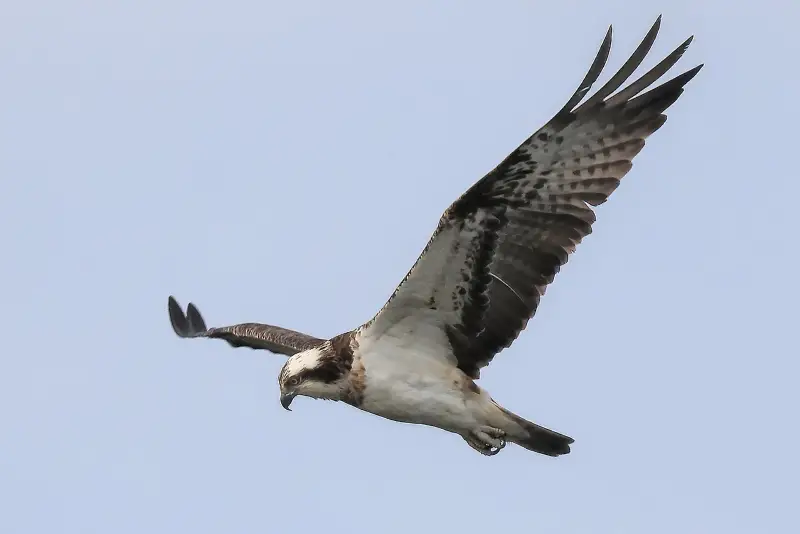
While the Osprey is technically not a hawk, it resembles a very large hawk with a wingspan of up to 69 in (5.5 ft).
It is usually easy to identify the Osprey due to its largely black and white appearance, as well as its habit of diving into the water.
This large North America bird is the only raptor species that plunges into water in order to catch fish, often becoming entirely submerged in the water as it attempts to grab a fish with its feet.
Due to this style of hunting, Ospreys are almost always found close to water, except during migration, when they will cross areas without water.
The Osprey is a widespread though rare breeding bird throughout northern North America, and also occurs as a winter bird in southern parts of North America.
Final remarks
In summary, here are the 9 types of hawks that have a white belly:
- Swainson’s Hawk
- Ferruginous Hawk
- White-tailed Hawk
- Short-tailed Hawk (light morph)
- Red-tailed Hawk (light morph)
- Northern Harrier (adult male)
- Swallow-tailed Kite
- Mississippi Kite
- White-tailed Kite
- Osprey
If you’ve spotted one of these raptors while bird watching, but aren’t sure which species it was, check our detailed bird identification guide with photos above.
If you enjoyed this article, check out our guide to the hawks of Florida.
